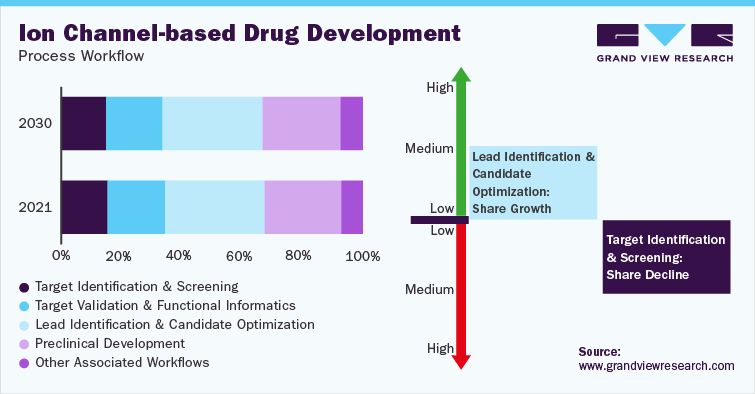
Ion Channels in Drug Discovery, 2023 Report
- Published: Apr, 2023
- Report ID: GVR-MT-100111
- Format: PDF, Horizon Databook
- No. of Pages/Datapoints: 35
- Report Coverage: 2024 - 2030
Increasing Use of Ion Channels in Drug Discovery
Ion Channels are the third largest group of target proteins used in drug discovery and currently have about 150 New Drug Entity (NDE) under preclinical and clinical studies. Drug discovery using ion channel targeted mechanism of action capture about 12-15% of the research studies conducted currently. As of 2008, there were only 13% of marketed drugs however as of 2022 this number has grown to 19%. As researchers become more aware of the potential of ion channels as pharmacological targets, the R&D activities on ion channel-based targets for drug discovery have improved over time. Ion channel modulators are used to treat a number of illnesses, including epilepsy, Parkinson's disease, cardiac arrhythmias, and autoimmune dysfunction.
Ion Channels in Drug Discovery Report Scope
|
Attribute |
Details |
|
Key Driver Analysis |
|
|
Key challenges |
|
|
Categorization of Ion Channels |
|
|
Regional Analysis |
Market performance across the 5 regions |
With the accomplishment of the complete human genome sequencing which was done in April 2022 as reported by the National Human Genome Research Institute (NHGRI), one is expected to witness the growth for ion channel-based drug development. Based on the gating mechanism, the study will analyze ligand-gated ion channels, voltage-gated channels, and others. Based on ion selectivity, the market is segmented into calcium channels, potassium channels, sodium channels, and others.
Based on workflow, the market is segmented into target validation & functional informatics, target identification & screening, preclinical development, lead identification & candidate optimization, and other associated workflow. Other associated workflow comprises tools, software, molecule visualization & handling instruments, and database management systems. Factors such as intensive research on novel drug candidates, increased investment for outsourcing, and a wide array of services offered by private entities in the area of drug discovery can be attributed to the growth of this segment as of 2022.

With the completion of human genome sequencing which was done in April 2022 as reported by the National Human Genome Research Institute (NHGRI), one is expected to witness the growth for ion channel-based drug development. It has been identified that over 400 human genes encode ion channels, thereby indicative of their involvement in the majority of physiological processes. This expansion of the application spectrum along with limited currently marketed drugs, showcases a huge potential space for the introduction of ion channel drug targets by the pharmaceutical companies. Along with small molecules, we are witnessing a rapid exploration of these drug entities within biopharmaceuticals as well.




